The Real McElroy
The Fire Chief Is Good and Has the Luck of the Irish

Pat McElroy, the City of Santa Barbara’s fire chief, is without doubt the best natural politician operating in Santa Barbara County that nobody ever voted for.
He damned well better be.
Given the dire challenges confronting every fire department throughout Southern California McElroy will need all his formidable skills, not to mention the proverbial luck of the Irish, to navigate the uncharted road ahead. Some of those challenges are excruciatingly obvious: extreme weather, prolonged drought, and the likely prospect that a backcountry blaze will turn into a front-country conflagration. Others are not so evident: Emergency medical treatment calls comprise 80 percent of the fire department’s caseload. Of those, many involve people without insurance looking for a trip to the emergency room. If the Affordable Care Act does what it’s supposed to, many such calls will disappear. But what does that mean for the allocation of fire department resources?
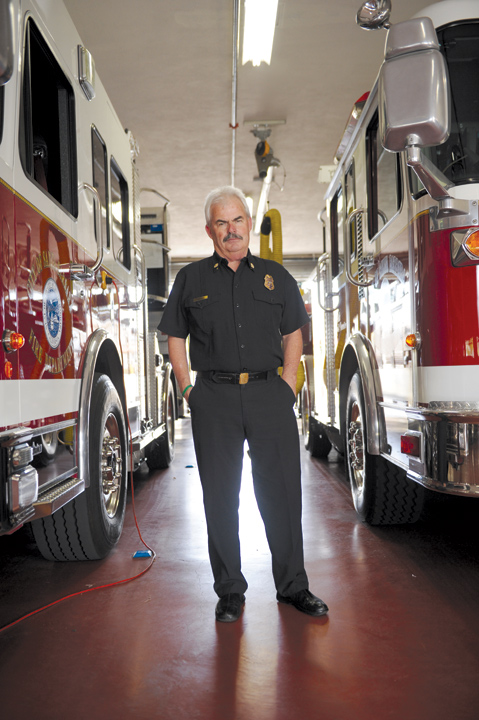
Where McElroy’s career trajectory is concerned — front-line firefighter to union leader and political power broker to fire chief — luck has played a minimal role. But McElroy, incontrovertibly, is extremely Irish. Though not one to wave the Danny Boy flag about — or sport the faux “sure ‘n’ begorrah” brogue — it’s a fact that McElroy’s grandparents on his father’s side emigrated from Ireland. So too did his great-grandparents on his mother’s side. McElroy himself — full name Patrick Joseph Michael — came into the world on St. Patrick’s Day 61 years ago. And what could possibly be more stereotypically Irish in America than working for the fire department?
In person, McElroy sports what’s often described as a shock of prematurely white hair, thick black horn-rimmed glasses, and a semi-permanent, semi-sideways grin. Naturally, he has the signature mustache required of all males serious about a career in public safety. McElroy isn’t particularly big, though he’s still plenty sturdy even 33 years after first joining the department. But in conversation, he is irresistible, all enthusiasm, curiosity, and generosity. And it’s all real, as is his obvious intelligence.
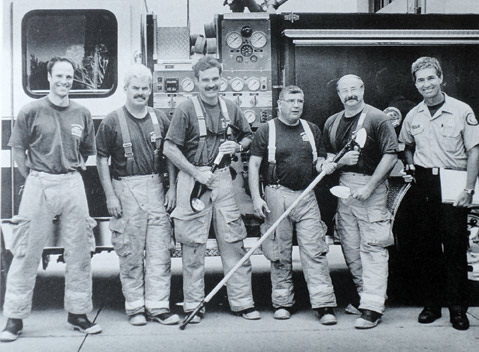
The Man Inside the Suit
McElroy, still a relatively new chief with just over a year at the helm, now occupies offices in the Fire Department’s new and improved downtown fire station. His digs boast high ceilings and an expansive window offering a CinemaScope view of Chapala Street. On his walls are detailed fire maps one would expect in any fire chief’s office. But McElroy ain’t your typical fire chief. Consequently, there are original concert posters from the 1970s and a photo — though admittedly photoshopped — of McElroy posing with the Rolling Stones. These only hint at what McElroy’s friends all know: Where music fanaticism is concerned, McElroy needs daily rabies shots.
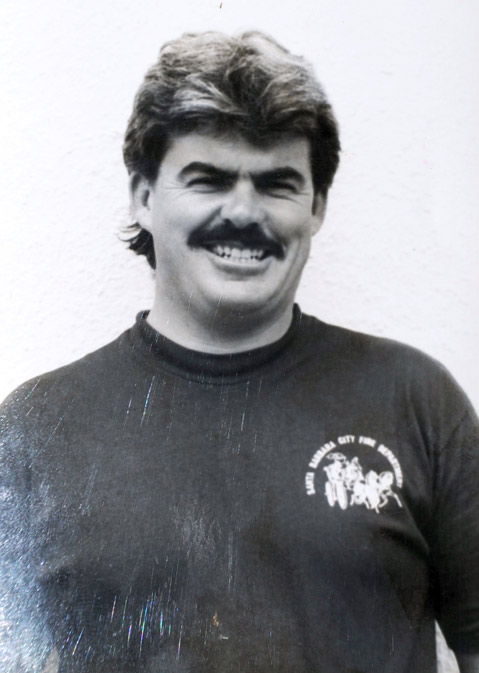
McElroy came of age in the late 1960s and remains to this day an unrepentant Deadhead. He speaks glowingly of the many concerts he attended at UCSB’s Rob Gym and recalls seeing Van Morrison — about the time Saint Dominic’s Preview came out — frozen with rigor mortis on the stage of the old Granada Theatre, struck by one of his occasional bouts of stage fright. There may be other fire chiefs throughout California who can brag about buying the underground Zap Comix featuring the painfully twisted genius of cartoonist R. Crumb when they first hit the streets, but probably not many. And probably even fewer who make passing reference to the music of John Fahey, one of America’s most intriguingly original — however addled and obscure — voices on the acoustic guitar.
And then there is his bookcase, an omnivore’s delight. There are biographies of baseball and football greats Sandy Koufax and Johnny Unitas, a book on Irish-American politics, another about Irish-American gangsters, Water and Power, the classic tome of California politics, a Big Lebowski paperback, Keith Richards’s autobiography, and enough books on former President Lyndon Johnson to keep a serious scholars of power politics busy for a year. And they’ve all been read.
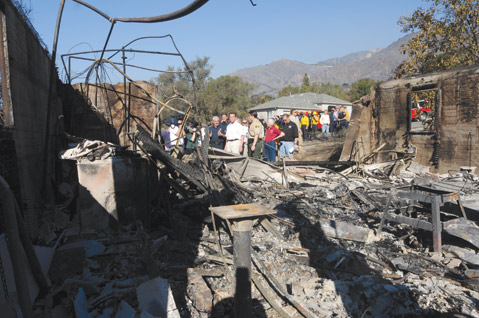
California’s Burning
One of McElroy’s more recent enthusiasms is the symposium on California wildfires now taking place at UCSB — courtesy of the Bren School of Environmental Science — in which experts from a wide array of disciplines are exploring different aspects of what’s become a growing menace. With 20 percent of the population moving over the past 20 years into previously uninhabited fire country, the series addresses a dangerous reality Santa Barbara has been grappling with for decades. The onslaught of extreme weather changes poses the questions more pointedly. California used to have a distinct “fire season.” Now it lasts all 12 months. In the month of January alone — traditionally one of the wettest months — California fire agencies have reported 450 fires.
Among the many experts McElroy exclaimed over was a tree-ring expert from Arizona State University, Tom Swetnam. “He shows these slides of giant trees, and looking at the rings, he can say, ‘Here’s the year Jesus was born, and here’s the time of the Reformation,’” McElroy explained. Swetnam’s research transcends the obvious realm of “Cool!” and “Wow!” and penetrates the plane of “Holy shit!” And not in a good way.
What the tree rings show — coupled with soil core analysis — is the intensity and frequency of droughts and fires throughout the Western United States over the past 2,000 years. The punch line is that in the past 100 years, fire fuels have accumulated to an unprecedented and dangerous degree because of the success achieved through aggressive fire suppression efforts. Making matters more combustible, Swetnam warned, over the past 25 years, springtime temperatures have reached record — and near record — heights for many years in succession. Even more dire, Swetnam cited research suggesting that if greenhouse gas emissions continue at current rates, by 2050 the average drought in the American West will be as bad as the worst droughts of the past 1,000 years.
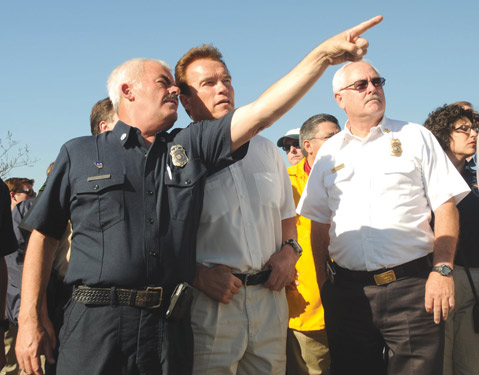
McElroy’s takeaway? “Forests change,” he said. “What we have on the ground today isn’t necessarily what we had 100 years ago. And it won’t necessarily be what we have 100 years from now. It used to be we were all grasslands and oak woodlands. Now we’re surrounded by a dense chaparral belt.”
The problem with chaparral is that it’s more likely than trees to burn, and when it does, it burns hotter, bigger, faster, and spreads farther. Chaparral is also significantly less susceptible to fire-prevention treatment regimes. This reality places a life-or-death premium on the South Coast’s “front country” residents maintaining defensible spaces by clearing brush from the perimeters of their properties, building with fire-resistant materials, and having in advance a “Ready, Set, Go” evacuation plan. Given the central role McElroy played fighting the Tea Fire, the Gap Fire, and the Jesusita Fire — which claimed 300 homes combined, 21,000 acres, and cost $50 million — none of this qualifies as a revelation. These are issues for which the department has already initiated programs that have been up and going for some time. Still, McElroy revels in really smart people examining the same problems he confronts and hearing what they have to say. “I just love that a university of this stature would bring experts from all over the country to look at what we do on the ground from 30,000 feet up,” he gushed. “It would be foolish for me not to try to learn from them all.”
Other fire chiefs had a different reaction. County Fire Chief Michael Dyer, a major political force in his own right and someone with whom McElroy enjoys exceptionally cordial relations, objected that the series organizers failed to invite the area fire chiefs, who — he acerbically noted — might have some valuable experience and insights to share. It seemed a legitimate beef.
McElroy’s response? “I just invited myself,” he said with a mix between shrug and a laugh. But he took it one step further; McElroy invited others in his field to attend. And they came. As a result, at some lectures, the front row of seats was entirely occupied by firefighters — all wearing their uniforms.
It was classic McElroy.

All in the Family
McElroy grew up in South Torrance in a middle-class housing tract populated by World War II vets and their burgeoning families. He described the neighborhood as being “crazy with kids.” McElroy was the oldest of seven children — six boys and one girl — and the family’s backyard basketball hoop became renowned as the scene of epic showdowns over the years. McElroy’s father was a self-taught materials supply engineer for Ralph Parsons, a mega powerhouse on par with companies like Bechtel and Fluor. “They built Saudi Arabia,” McElroy explained. His parents met in Avalon on Catalina Island in 1951, where McElroy’s father — his family worked for the Wrigleys who owned the island — spent much of his early boyhood.
Politically, McElroy’s father was a Kennedy Democrat and his mother a Goldwater Republican. Normally, such a combination might produce sparks. That it didn’t might be because the McElroy family was experiencing its own “question authority” moment. When McElroy’s younger brother Matthew was born with Down’s syndrome 52 years ago, the doctors strongly advised his parents not to bring him home. He would “ruin” the family, they said. That was the medical orthodoxy of the time. Back then, a doctor’s word was second only to God’s. Even so, the McElroy family rebelled. They brought Matthew home and circled the wagons with clannish ferocity. “My parents taught me certain slurs were never to be ignored,” McElroy would write later. “Woe to anyone who crossed the McElroy brothers and sister over Matthew.”
McElroy’s mother would publicly confront best-selling author Leon Uris because he used the term “Mongoloid” — then a common term for people with Down’s syndrome — in his book Ireland: A Terrible Beauty. Uris would later send McElroy’s mother a written apology, deleted the word from the book’s later editions, and sent Matthew an autographed copy. Matthew, a phenomenally accurate shooter on the basketball court, would go on to participate in the very first Special Olympics and appear in ads for the event with the L.A. Lakers.
McElroy cites this as a defining moment in his development both politically and personally. The lessons learned, he said, were all about “compassion, resilience, and loyalty.” It also taught him, he said, to respond to underdogs with kindness.
“If you wanted to do anything there, you had to be union,” he recalled. “I mean, it was union union.”
McElroy didn’t grow up wanting to be a firefighter. He’d always wanted to be a teacher instead. In 1971 — a year after the Isla Vista bank burning — he enrolled at UCSB, majoring in anthropology. Mostly, he wallowed in all the music. As a student, McElroy performed poorly and dropped out after the first year. He held a variety of jobs but wound up working at a refinery near Long Beach. It was his first taste of union politics. “If you wanted to do anything there, you had to be union,” he recalled. “I mean, it was union union.” But when his older coworkers found out McElroy had dropped out of university, they gave him no peace. “They got mad at me,” he recalled. “It was like I had this opportunity that I wasn’t taking. It made no sense to them.”
McElroy got the message. He went back to UCSB and finished in 1977. More crucially, he would meet Bonnie Kerwin — then a student and now his wife and mother of their three kids — who is well known for her work with the Starr King Parent-Child Workshop.
McElroy fell into firefighting as a student as way to make money in the summer. He started off working for the Forest Service’s “Blue Card” crew, cleaning up fires that had mostly been put out. It was there he would first work with future city fire chief Andy DiMizio. When the Sycamore Canyon Fire ravaged Santa Barbara in 1977, McElroy was involved. “I knew this was what I wanted to do,” he said.
In 1981, McElroy took the test for the Santa Barbara City Fire Department. He passed. The chief then was Al Faoro, the first of five McElroy would work under. He recalled responding to his first structure fire. “We showed up in the middle of the night, and I said, ‘Oh man, I got to call somebody,’” he said. “The next moment I thought, ‘They did. And it’s us.’”
Over the years, McElroy would quickly emerge as “the firefighters’ firefighter.” To an exceptional degree, regardless of rank, he became the most visible face the department had. It wasn’t that he rescued every cat from every tree or every child from every burning building — it just seemed that way. When the Jesusita Fire first broke out in 2009, McElroy was one of the first two firefighters on the scene, boots on the proverbial ground. Most of the firefighters he started his career with were long retired by then. “If there was a children’s book called ‘My Life as a Firefighter,’” commented Mayor Helene Schneider, “It would have Pat’s picture on the cover.”
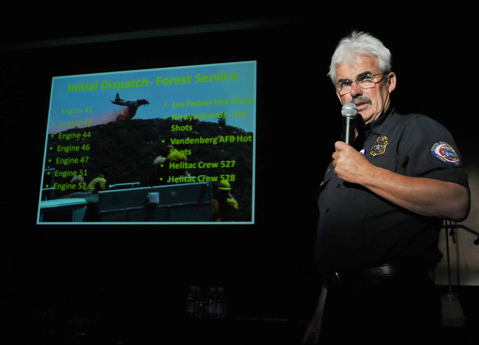
Union-Made
When McElroy started, fire departments were changing. They used to be top-down, militaristic chain-of-command operations populated with people who came of age during World War II or the Korean War. Younger firefighters bristled at the rigidity. And the public demanded departments capable of conducting two-way conversations. In this changing context, McElroy was golden. He was young, good-looking, and ridiculously poised and professional in front of TV cameras. Reporters didn’t make McElroy nervous. He liked talking to them. And he was good at it. And if the editor of the daily paper wanted his grandson to get a ride in a fire truck, McElroy was happy to oblige.
When McElroy turned his attention to union politics, City Hall suddenly found itself holding a tiger by the tail. At the beginning of his career, city firefighters were represented by a trade association unaffiliated with any other labor organizations. McElroy quickly set about to change that, replacing the association with a bona fide union. And though he insists he served only one term as president, it was largely McElroy’s union until he was promoted to management.
McElroy jumped feet first into political campaigning, cutting his teeth in 1982 when City Council candidate Tom Rogers won his seat. Rogers was a charismatic pragmatist, an ambitious, talented moderate Democrat with an environmental bent. Not only did Rogers win that race, but he and McElroy became close personal friends. Rogers — whose life and promising political career would be prematurely ended by Lou Gherig’s disease — was the first of many candidates the union would endorse. And such endorsements typically included sizable financial contributions, paid ads, and best of all, squads of burly good-looking firefighters walking precincts and knocking on doors.
On political matters, McElroy worked intimately with Sergeant Mike McGrew of the Police Officers Association (POA). McGrew’s father, Warner McGrew, was one of the fire chiefs McElroy worked for over the years. (Warner, also Irish, would be the first union leader to be made fire chief.) Over time, McElroy and the chief’s son would team up to create the Pat-n-Mike show, the now legendary guns-and-hoses (police and fire) political coalition. To the extent possible, the police and fire unions sought to coordinate their endorsements to maximize their impact. Even today — with the unions’ collective reputations diminished by public resentment over their members’ high retirement benefits — the two unions remain among the most influential endorsements any candidate can get.
“It was huge,” recalled Mayor Schneider of the firefighters’ first endorsement she received in 2003.
“It was huge,” recalled Mayor Schneider of the firefighters’ first endorsement she received in 2003. It was her very first race. She was running for the City Council as part of a progressive, social justice slate. Schneider was working for Planned Parenthood at the time. She first met McElroy when he responded to a possible bomb threat. “He was being Pat McElroy,” she said. In that race, Schneider was the only crossover candidate who won support from both public safety and the social justice camps. “For me, it was a really big deal,” she said.
Over the years McElroy has insisted the union didn’t merely endorse the candidates who promised the biggest raises. “There was never any tit-for-tat,” he said. “We looked at the broader interests of the department. Mostly, we just want someone we can talk to.” The union did, in fact, endorse noted fiscal conservative Dan Secord. In one instance, Schneider said, City Hall negotiated a deal with the union that wound up saving City Hall significant sums in additional retirement costs. This was accomplished by allowing the existing firefighters to work more overtime hours rather than hiring new employees to get the work done. But mostly, the union wanted better wages and benefits. In this regard, nobody ever accused McElroy of not bargaining hard.
McElroy had weight to throw around, and on occasion he did just that. Disgusted by the political infighting roiling the council ranks in 2005 — and upset at what the union considered bad faith by management — the firefighters union opted not to endorse anyone in 2007, not even the incumbents it had supported in the previous election. This had definite ramifications and probably allowed conservative Republican Dale Francisco to beat out moderate incumbent Brian Barnwell. (Francisco is now one of the many Republicans running to unseat incumbent Congressmember Lois Capps.) That same year, the firefighters union and the POA came out against a ballot measure backed by the City Council to change the council’s traditional off-year elections to coincide with state and federal elections. It would have saved City Hall hundreds of thousands of dollars a year. It would also have increased voter turn out by 15-20 percent. McElroy argued at the time that city council elections should be decided by city-minded voters focused on city-minded issues, not hot button state and federal issues that had no bearing on City Hall deliberations. He did not need to say the change would have diluted the union’s political influence. That much was obvious. The measure lost badly.
Although joined at the hip, McElroy and McGrew had decidedly distinct styles. McGrew and the POA openly solicited candidates to run against incumbent mayor Marty Blum. When that effort failed and Blum won reelection, McElroy made a point to send the mayor a bouquet of flowers.
Throughout the budget cutting of the recession, the police and firefighters unions were under intense pressure from City Administrator Jim Armstrong to make significant concessions. Armstrong insisted their members pay the same percentage into their retirement accounts as general employees did. Although both unions would eventually ratify contracts with this provision, the conflict got nasty and personal. POA chief McGrew would accuse Armstrong of waging a “jihad” against the police, accusing him of putting the public’s safety at risk. Among some public-safety union members, Armstrong emerged as an iconic villain. He was hiding revenues, they charged, to make the recession appear worse than it actually was to justify cuts he wanted to make rather than cuts that had to be made. At times, the POA threatened to initiate a recall campaign against Councilmember Dale Francisco, a staunch fiscal conservative. (It never did.) Likewise, the POA has toyed loudly with a ballot initiative that would strip Armstrong of his power to appoint the fire and police chiefs, giving that authority to the City Council instead. Thus far, that’s gone nowhere.
Throughout this acrimony, the firefighters managed to play the role of “good cop” to good effect, agreeing to concessions that the police would loudly denounce then later accept. While some of this melodrama took place after McElroy had been promoted to management — first as battalion chief and then as operations chief — the firefighters union had always made a point to keep the dispute professional. By doing so, it scored points. So did McElroy.
In 2013, City Administrator Jim Armstrong picked McElroy to replace Andy DiMizio, who was retiring as fire chief. Acknowledging the conflicted history between Armstrong and McElroy, Mayor Schneider commented, “That Jim [Armstrong] would pick Pat [McElroy] to be fire chief, I think speaks well for both of them.” Armstrong said, “It’s not to say we didn’t butt heads and disagree. We did. But he was always professional.” McElroy, he knew, had obvious leadership skills. Since then, he’s been “amazed” at his ability to anticipate problems three or four years down the road. And, he added, “I like his passion.”
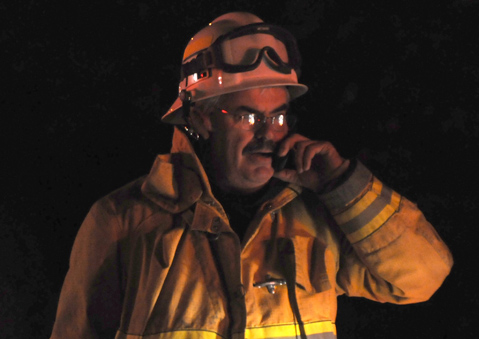
Wet on Red
Former fire chief Warner McGrew described fighting fires as “putting the wet stuff on the red stuff.” That hasn’t changed since McElroy first joined the department. What has changed is how the wet stuff gets there. Some of this is technical. Eight high-tech “flame sniffers,” for example, are planned for installation on top of Edison power poles around Mission Canyon — at a cost of $20,000 each — to help detect fires when they’re still small. Thanks to a Homeland Security grant, the Santa Barbara County Fire Department now has a helicopter equipped with a video camera so firefighters on the ground better know what to expect as they arrive at the scene of a fire. Night-vision goggles allow helicopter pilots to drop retardant and water in the dark, still a relatively new development for Santa Barbara County. Cell phones, the Internet, and social media all provide vastly faster avenues of communication between fire departments and their crews, not to mention the field commanders and the public.
When a major fire breaks out, no one department can put it out. California fire departments have long-standing mutual aid agreements in which they come to each other’s rescue. The bigger the fire, the more jurisdictions are involved: state, federal, and many counties and cities. The possibility for confusion is infinite; the cost of such confusion is even higher. Imagine creating a new city under less than optimal conditions — providing meals, Port-a-Potties, sleeping accommodations, showers, and communications overnight. Imagine having to account for every penny spent and securing funding authorization simultaneously. And imagine having to work with law enforcement to evacuate 47,000 city residents without looting or incident. Imagine coordinating with Public Works to shift water from one reservoir to another so there’s enough water pressure to fight fire. Imagine doing all this simultaneously, and you get the idea. Endless hours of planning and preparation between agencies and within agencies are required. “Pat’s best work may be all the stuff he does when nothing is happening,” said UCSB political science Professor Sarah Anderson, who helped instigate the Bren School wildfire program.
“When the flames are flying and you’re stuck on the side of a hill, things can get pretty tense and pretty intense,” said County Fire Chief Dyer. “The bottom line is that I trust Pat, and Pat trusts me.”
McElroy brings 30 years of relationships working with other first responders throughout the state. When they show up in Santa Barbara to help, they don’t necessarily know where to tread lightly. They have to be told, and personal connections matter. In fires, they matter a lot. “When the flames are flying and you’re stuck on the side of a hill, things can get pretty tense and pretty intense,” said County Fire Chief Dyer. “The bottom line is that I trust Pat, and Pat trusts me.”
With McElroy, it’s not merely connections. It’s also experience. Beyond the fires that left lasting scar tissue on Santa Barbara’s psyche, McElroy has served at high levels with the incident command teams in major disasters throughout the state and nation. Typically, McElroy served as liaison officer, a fancy title for herding cats. If help from a utility company was needed, it would be McElroy’s job to connect with the right person. And fast. During Hurricane Katrina, McElroy was dispatched to Mississippi, where he worked alongside the late Herb McElwee, the former chief of the Montecito Fire Department. “Herb had this magical ability to get along with people,” McElroy recalled. That happened to be precisely the magical ability the moment called for. “It was our job to find the person in charge whose permission we needed to get to do what we needed to do,” explained McElroy. McElroy also served as liaison officer for the incident command team at the Day Fire as well, which burned out 162,700 acres in Los Angeles, Ventura, and Kern counties. It fell to McElroy to notify the California Highway Patrol that the fire commanders were shutting down Highway 5, over which hundreds of millions of dollars worth of goods and services travel daily.
Special skills are required to be an effective liaison officer. “Pat gets people to work together, to respect each other,” said his former boss Andy DiMizio. “He has an innate ability to find the middle ground,” agreed former fire chief McGrew. “Not everybody has that.”
Santa Barbara’s next big fire is a matter of when, not if. None have taken place thus far on McElroy’s watch. As chief, he said, he’s gained greater appreciation that fighting fires requires coordination at every level within City Hall. As chief, he said he needs to be mindful that other departments suffered more than his during the recession. “You have an opportunity to be less myopic,” he said. “Whether you take that, that’s your choice.”
McElroy readily acknowledges that his position — not to mention skill set and inclination — is political. But he insisted he has no interest in elected offices. “I don’t have the temperament,” he said. “I’m too reactive.” Likewise, he insisted that luck has, in fact, played a major role in his career. Today’s firefighters, he said, come to the job with far more experience and expertise than he had. “Timing is everything,” he said. “If I had to apply for my job today, I don’t think I could compete.”



